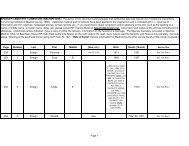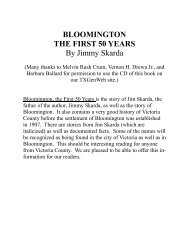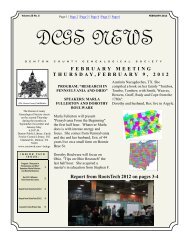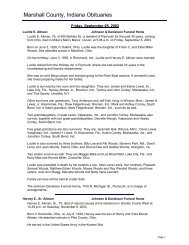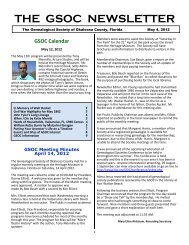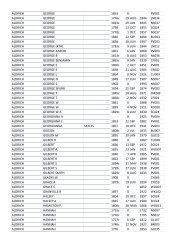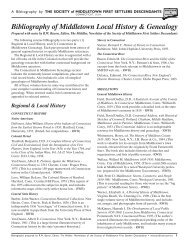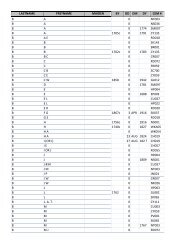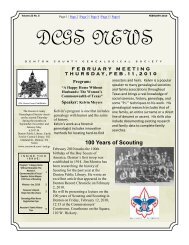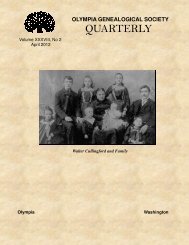Indian population in the United States and Alaska. 1910 - RootsWeb
Indian population in the United States and Alaska. 1910 - RootsWeb
Indian population in the United States and Alaska. 1910 - RootsWeb
Create successful ePaper yourself
Turn your PDF publications into a flip-book with our unique Google optimized e-Paper software.
98 INDIANS IN THE UNITED STATES.<br />
Paiute (see also Paviotso.)—^A tribal name which has<br />
been very loosely applied <strong>and</strong> <strong>in</strong> consequence is of<br />
uncerta<strong>in</strong> application. Used at different times for sev-<br />
eral of <strong>the</strong> Shoshonean tribes of <strong>the</strong> <strong>in</strong>terior plateau,<br />
it is properly restricted to <strong>the</strong> <strong>Indian</strong>s of southwestern<br />
Utah <strong>and</strong> <strong>the</strong> adjacent portions of sou<strong>the</strong>rn Nevada,<br />
California, <strong>and</strong> northwestern Arizona. The Paiute, as<br />
so def<strong>in</strong>ed, have occupied this same area s<strong>in</strong>ce known<br />
to Europeans.<br />
The number enumerated <strong>in</strong> <strong>1910</strong> was 780, of which<br />
247 were <strong>in</strong> Nevada, 238 <strong>in</strong> Utah, <strong>and</strong> 210 <strong>in</strong> California.<br />
No comparison can well be made with earlier years, as<br />
<strong>the</strong> use of <strong>the</strong> name Paiute has been so variable. In<br />
1873 what are above def<strong>in</strong>ed as Paiute were estimated<br />
at 2,027. The report of <strong>the</strong> Commissioner of <strong>Indian</strong><br />
Affairs gives <strong>the</strong> total <strong>in</strong> <strong>1910</strong> as 819, of whom only 449<br />
were under <strong>the</strong> control of <strong>the</strong> <strong>Indian</strong> Office.<br />
Panam<strong>in</strong>t.—A group or b<strong>and</strong> occupy<strong>in</strong>g, s<strong>in</strong>ce known<br />
to EuropeaJQs, <strong>the</strong> region of Panam<strong>in</strong>t Valley, Inyo<br />
County, Cal. The number enumerated <strong>in</strong> <strong>1910</strong> was 10,<br />
of which 9 were <strong>in</strong> California <strong>and</strong> 1 <strong>in</strong> Nevada.<br />
Paviotso (syn. Snake).—Probably <strong>the</strong> most conven-<br />
ient term under which to group <strong>the</strong> Snakes <strong>and</strong> socalled<br />
Paiutes of sou<strong>the</strong>astern Oregon, western Nevada<br />
<strong>and</strong> <strong>the</strong> eastern edge of California as far south as Lake<br />
Tahoe. They are very closely allied to <strong>the</strong> Mono <strong>and</strong><br />
can be separated from <strong>the</strong>m <strong>in</strong> <strong>the</strong> present enumera-<br />
tion only somewhat arbitrarily, as <strong>the</strong> latter are also<br />
sometimes locally known as Paiutes. As enumerators<br />
failed to distiaguish between <strong>the</strong> true Paiute <strong>and</strong> <strong>the</strong><br />
Paviotso, an arbitrary but approximately correct divi-<br />
sion was made by tabulat<strong>in</strong>g as Paiute only those enumerated<br />
with<strong>in</strong> <strong>the</strong> area known to have been occupied<br />
by <strong>the</strong>m <strong>and</strong> class<strong>in</strong>g as Paviotso all Paiute enumerated<br />
<strong>in</strong> <strong>the</strong> area above def<strong>in</strong>ed as <strong>the</strong> Paviotso habitat.<br />
Ow<strong>in</strong>g to <strong>the</strong> impossibility of separat<strong>in</strong>g <strong>the</strong> Paviotso<br />
with certa<strong>in</strong>ty from <strong>the</strong> Paiute <strong>and</strong> <strong>the</strong> Mono, <strong>the</strong> fig-<br />
ures must be regarded as approximate only.<br />
So far as known, <strong>the</strong> Paviotso have always occupied<br />
<strong>the</strong> area above outl<strong>in</strong>ed. At present <strong>the</strong>y are to be<br />
found widely scattered throughout this area, a m<strong>in</strong>ority<br />
beiag located on <strong>the</strong> follow<strong>in</strong>g reservations: Pyramid<br />
Lake, Walker River, <strong>and</strong> Duck Valley (Western<br />
Shoshoni) Reservations, Nev.; Fort Bidwell School,<br />
Cal. ; Klamath Reservation, Oreg. (known here as Walpapi<br />
<strong>and</strong> Yahusk<strong>in</strong> Snakes); <strong>and</strong> Warm Spr<strong>in</strong>gs Res-<br />
ervation, Oreg.<br />
The number enumerated <strong>in</strong> <strong>1910</strong> was 3,038, distributed<br />
as follows: Nevada, 2,414; Oregon, 341; Idaho,<br />
152; California, 101; <strong>and</strong> scatter<strong>in</strong>g, 30. No comparison<br />
which is of value can be made with earlier years.<br />
San Luiseno (syn. Luiseno).—A subdivision of <strong>the</strong><br />
California Shoshonean, occupy<strong>in</strong>g <strong>in</strong> <strong>the</strong> eighteenth<br />
century an area ia western Riverside <strong>and</strong> northwestern<br />
San Diego Counties, tributary to <strong>the</strong> Mission of San<br />
Luis Rey. They are now located ma<strong>in</strong>ly on several<br />
small reservations ia this area.<br />
The number enumerated <strong>in</strong> <strong>1910</strong> was 467, all <strong>in</strong> Cali-<br />
fornia. Comparison with earlier years is difficult, as<br />
<strong>the</strong> use of <strong>the</strong> term has not always been uniform, <strong>and</strong><br />
<strong>the</strong> figures given <strong>in</strong> <strong>the</strong> reports of <strong>the</strong> Commissioner of<br />
<strong>Indian</strong> Affairs probably <strong>in</strong>clude persons belong<strong>in</strong>g to<br />
o<strong>the</strong>r tribes. The figures back to 1870, however, are<br />
as follows:<br />
.<br />
TEAR.



